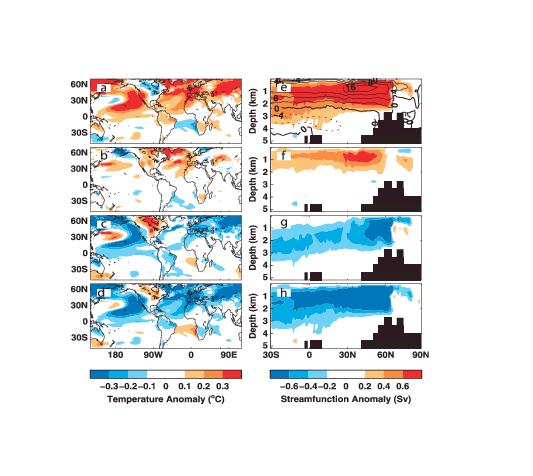- HOME |
- PEOPLE |
- RESEARCH |
- PUBLICATIONS |
- NEWS AND EVENTS |
- SEMINARS
Geophysical Research Letters Article Highlighted by AGU
Natural ocean cycles will soon weaken thermohaline circulation
 The Atlantic Multidecadal Oscillation (AMO) is a pattern of multi-decadal surface temperature variability centered on the North Atlantic Ocean, seen in analyses of global climate using measurements dating back to the 19th century. Shown to have been linked with Sahel drought, Brazilian rainfall rates, North American climate, and Atlantic hurricane frequency, studies of these 50-100 year fluctuations are hindered by short global climate records and insufficient subsurface ocean data. Thus, it is difficult to conclude whether the Atlantic Multidecadal Oscillation is genuinely oscillatory. To clarify this, Knight et al. examined a 1,400-year simulation that replicates the observed pattern and amplitude of the Atlantic Multidecadal Oscillation. Their results imply that the Atlantic Multidecadal Oscillation is a genuine quasi-periodic cycle, related to the variability in the oceanic thermohaline circulation. Using this relationship, they attempted to reconstruct past thermohaline circulation changes and observed an increase in thermohaline circulation strength over the last 25 years. Due to the Atlantic Multidecadal Oscillation's oscillatory nature, the authors inferred a decreasing thermohaline circulation strength over the next few decades, which would accelerate the anticipated human-caused weakening of the same phenomenon. They suggest that future climate change predictions need to account for natural changes expected from shifts in the Atlantic Multidecadal Oscillation.
The Atlantic Multidecadal Oscillation (AMO) is a pattern of multi-decadal surface temperature variability centered on the North Atlantic Ocean, seen in analyses of global climate using measurements dating back to the 19th century. Shown to have been linked with Sahel drought, Brazilian rainfall rates, North American climate, and Atlantic hurricane frequency, studies of these 50-100 year fluctuations are hindered by short global climate records and insufficient subsurface ocean data. Thus, it is difficult to conclude whether the Atlantic Multidecadal Oscillation is genuinely oscillatory. To clarify this, Knight et al. examined a 1,400-year simulation that replicates the observed pattern and amplitude of the Atlantic Multidecadal Oscillation. Their results imply that the Atlantic Multidecadal Oscillation is a genuine quasi-periodic cycle, related to the variability in the oceanic thermohaline circulation. Using this relationship, they attempted to reconstruct past thermohaline circulation changes and observed an increase in thermohaline circulation strength over the last 25 years. Due to the Atlantic Multidecadal Oscillation's oscillatory nature, the authors inferred a decreasing thermohaline circulation strength over the next few decades, which would accelerate the anticipated human-caused weakening of the same phenomenon. They suggest that future climate change predictions need to account for natural changes expected from shifts in the Atlantic Multidecadal Oscillation.
Knight, J.R., Allan, R.J., Folland, C.K., Vellinga, M., Mann, M.E., A signature of persistent natural thermohaline circulation cycles in observed climate, Geophysical Research Letters, 32, L20708, doi:10.1029/2005GL024233, 2005.
Article available here:
http://www.meteo.psu.edu/~mann/shared/articles/KnightetalGRL05.pdf

